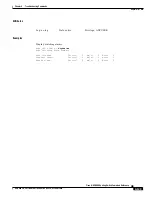
9-121
Cisco MGX 8850 Routing Switch Command Reference
Release 2.0, Part Number 78-10467-04 Rev C0, October 2001
Chapter 9
Troubleshooting Commands
dspndalms
dspndalms
Display Node Alarms
Displays various types of alarms on the node from a high-level perspective. With the information in the
dspndalms display, you can select one of the following commands to investigate the alarm:
•
dspcdalms identifies line, port, or connection alarms on an AXSM.
•
dspclkalms shows alarms related to network clocks.
•
dspenvalms lists alarms for out-of-range conditions for temperature, voltage sources, and so on.
•
dspslotalms shows card-level alarms, such as a missing card or a disk problem on the PXM-HD.
•
dspswalms shows alarms related to the switching fabric on the PXM45.
The preceding commands execute on the PXM45. If the results of the preceding commands seem to
warrant it, you can cc to another card and execute alarm-specific or other troubleshooting commands.
Use the help (or ?) on the CLI of the other card to see available alarm commands (? alm, for example).
The definition of each alarm severity comes from Bellcore TR-NWT-000474. An alarm can be:
•
Critical, indicating complete, non-recoverable failure, loss of data, and do on. The failed entity must
be restored. A power failure or a line being disconnected is an example.
•
Major, indicating service-affecting errors. This event indicates that a major service is damaged or
lost, but the existing traffic is not affected.
•
Minor, indicating non-service affecting errors or errors on a remote node. Corrective action is
appropriate to prevent a serious fault from developing. An example is a fan failure, where no
subscribers are immediately affected, but calamity could result if the situation persists. Note that an
accumulation of lower-level alarms does equal a higher-level alarm.
Cards on Which This Command Runs
PXM45
Syntax
dspndalms [slot]
Syntax Description
Related Commands
dspalm, dspalms
Attributes
slot
The slot number of the card.
Log: no log
State: active
Privilege: ANYUSER
















































